Astelia fragrans (Kakaha, Bush Lily)
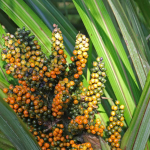 Sold Out
Sold Out
Astelia fragrans, commonly known as bush lily, bush flax or kakaha, is the most common astelia species found in New Zealand. It grows from sea level to elevations of approximately 900 metres. It has attractive broad green flax-like leaves, stiffly arched and the ribs are often reddish. It has scented flowers in Spring. When the berries mature over summer, they turn orange. Lizards feed on the berries and use the foliage to hide, making any Astelia a good addition if you want to attract lizards to your garden. Best in sheltered semi-shade.
Habitat: Kakaha occupies a range of semi-shaded, moist sheltered sites. It can be found on forest floors, cliffs, rock bluffs, lakeshore scarps and stream margins, as well as in swamps.
Flowering: Spring [October - November]
Fruiting: Summer - Autumn [December - May]
Astelia grandis (Kakaha, Swamp Astelia)
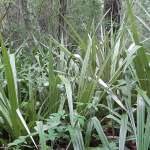 Sold Out
Sold Out
Astelia grandis, or Kakaha, is the largest of our Astelias, growing to 2m much like Harakeke. It has very broad olive green leaves with a silvery sheen beneath and reddish-purple midribs. The leaves are more erect and less tapered than A.fragrans. Forms clumps to 2m. The Female has orange berries. As a result, the female plant is a good lizard and bird attractor. These sweet juicy berries are edible even when raw.
It is an understory plant in lowland swamp forests or Kahikatea forests, but it is found mostly in the warmer areas of the South Island. Dioecious, meaning male and female plants must be grown if seed is required
Habitata: Kakaha occupies a range of moist sites. It can be found on forest floors, cliffs, rock bluffs, lakeshore scarps and stream margins, as well as in swamps. Best in sheltered semi-shade.
Flowering: Spring [September - October]
Fruiting: Summer [December to February]
Astelia nervosa (Kakaha, Mountain Astelia)
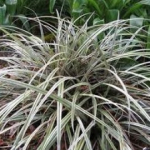
Astelia nervosa, commonly known as Mountain Astelia, is a distinctive evergreen perennial plant that is native to New Zealand. It belongs to the Asteliaceae family and is known for its striking foliage and unique form, making it a popular choice for ornamental gardens and landscapes.
The leaves of Astelia nervosa are the main feature of this plant. They are long, narrow, and sword-shaped, with a silvery-blue or grey-green color. The leaves are arranged in a clumping, basal rosette form, and can grow up to 90 centimeters in length, creating a dramatic and architectural presence in the garden.
The foliage of Astelia nervosa is typically stiff and leathery, with serrated edges, and may have a slight twist or curl, adding to its unique appearance. The silver-blue or grey-green color of the leaves provides a striking contrast against other plants in the garden and can create a bold focal point or add texture and interest to mixed plantings.
Astelia nervosa produces inconspicuous flowers that are held on tall, slender stalks that rise above the foliage. The flowers are typically small, brownish or greenish in color, and are followed by small, fleshy fruit.
Astelia nervosa is a hardy plant that is well-adapted to a range of growing conditions, although it prefers well-drained soils and partial shade to full sun. It is tolerant of coastal conditions, making it suitable for coastal gardens, and is also known to be deer-resistant.
In landscaping, Astelia nervosa is often used for its striking foliage and unique form. It can be used as a specimen plant, in mixed plantings, or in containers to create a bold and dramatic focal point. It is also well-suited for modern or contemporary gardens, as well as tropical or exotic-themed gardens.
Habitat: Found on mountainsides in forests and damp grasslands in the montane to the sub-alpine zone.
Flowering: Summer [January - February]
Fruiting: Autumn [February - May]
Astelia nervosa Westland (Bronze Bush Flax)
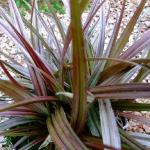
Astelia nervosa Westland with its fabulous foliage is ideal for group planting. Silvery, strap like foliage that is attractively flushed with red and bronze tones. The red colour intensifies in cold weather. Tolerant of sun or part shade but not tolerant of 'wet feet'. Astelia look their best when group planted and they are a fabulous easy care architectural container plant. Evergreen. Hardy.
Flowering: Summer [January - February]
Fruiting: Autumn [February - May]
Coprosma acerosa (Tataraheke, Sand Coprosma)
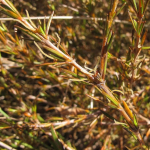
Coprosma acerosa, or sand coprosma, is a groundcover that is found naturally near the coast throughout New Zealand. Great for windy, coastal areas which get dry winds. The small needle-like deep green leaves clothe the intertangling branches that form springy mounds with a spread of up to 1m. Useful grown in areas prone to erosion, on banks, or over walls. Can also be easily incorporated into mixed shrub planting as a ground cover. In addition to bank stabilisation and as a mixed groundcover, native gecko species love the berries. As a result, this is a good addition to a revegetation project looking to increase biodiversity in the area. When plants of both sexes are present, attractive smoky blue berries follow the tiny green flowers. This is an excellent plant for coastal areas and hot dry conditions.
Habitat: Coastal sand dunes.
Flowering: Spring [September - December]
Fruiting: Autumn [February - May]
Tags: ErosionControl, PoorSoils, Rongoa
Coprosma areolata (Thin Leaved Coprosma)
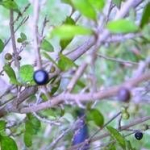
Coprosma areolata grows as a divaricating shrub or small tree to 3m, usually erect in habit. The pale green leaves are small and thin, hence the common name Thin Leaved Coprosma. It produces blue or black berries which the birds can eat. Grows in wet, lowland forest and can also grow in exposed places.
Habitat: Lowland to lower montane forest.
Flowering: Spring [October - December]
Fruiting: Summer [January - March]
Coprosma brunnea (Brown Stemmed Coprosma)
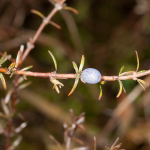
Coprosma brunnea is one of 45 species of Genus Coprosma that are found in New Zealand. A hardy wiry shrubby groundcover that is very tough and suitable for harsh conditions. Dense and bushy with attractive chocolate brown coloured foliage, grows tight and covers well. Ideal for trimming and mass planting on banks and swales, or sprawling down steep hill faces. Very small flowers develop from August to October among the branches and the female plant, in January, develop 5-6 mm long drupes which are a translucent sky-blue or are translucent white with blue flecks.
They also provide habitat for New Zealand’s declining lizard and gecko populations. As attractors of these small animals, they are a pioneer shrub in revegetation projects. Mingimingi provides a tough shelter, providing good food for native birds and lizards, as well as ground cover for these. Hardier the C. acerosa.
Coprosma species have small unisexual flowers that are borne on different plants (dioecious) and they have a fleshy fruit (drupe).
Habitat: Plains to subalpine. Coprosma brunnea grows in lowland to higher montane river beds up to 1500m in open grassland and rocky places on the South and Stewart Islands of New Zealand.
Flowering: Spring [August - December]
Fruiting: Summer - Autumn [January - June]
Tags: DrainField, ErosionControl
Coprosma crassifolia (Mingimingi)
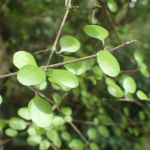
Coprosma crassifolia, commonly called mingimingi, is a stiffly-branched upright shrub with small dark-green leaves and white to pale-yellow berries that attract skinks and birds. It's a tough shelter and revegetation shrub for drought-prone sites. The upright, columnar habit is good for narrow spaces.
In the forest, the shrub is sparsely branched but in the open, it forms densely branched thickets. The stiff, more or less round remote leaves and the stiff, red-brown branchlets distinguish C. crassifolia from all other Coprosma species. The flowers are unisexual. The berries flesh is transparent but look white due to the white seed within. They may also look pale yellow.
Habitat: Coastal rocky and sandy lowland to lower montane shrubland and forest, up to 600 m.
Flowering: Spring [September - October]
Fruiting: Summer - Autumn [November - June]
Coprosma propinqua (Mingimingi)
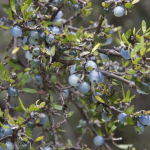
Coprosma propinqua, commonly known as Mingimingi, is a species of evergreen shrub or small tree that is native to New Zealand. It belongs to the family Rubiaceae and is known for its distinctive foliage and attractive appearance.
Coprosma propinqua exhibits a compact and bushy growth habit, typically reaching a height of 1 to 3 meters. The leaves are opposite, simple, and small, measuring about 1 to 3 centimeters in length. The leaves are elliptical or lanceolate in shape, with smooth margins, and are usually glossy and dark green in color. Some varieties may have variegated leaves with contrasting colors, such as yellow or cream markings.
The flowers of Coprosma propinqua are small and inconspicuous, typically greenish or yellowish in color. They are borne in clusters and are not particularly showy. The plant is dioecious, which means that male and female flowers are borne on separate plants.
The fruit of Coprosma propinqua is a fleshy drupe, typically spherical or ovoid in shape, and about 5 to 7 millimeters in diameter. The fruit initially appears green, but matures to a dark purple or black color when ripe. The fruit is often eaten by birds, which help to disperse the seeds.
Coprosma propinqua is commonly found in various habitats in New Zealand, including forests, shrublands, and coastal areas. It is known for its ability to tolerate a wide range of growing conditions, including poor soils and exposure to salt spray, making it a hardy and adaptable plant. It is also known to have medicinal properties and has been used traditionally by Maori for various purposes.
In cultivation, Coprosma propinqua is often used as an ornamental plant in gardens and landscapes due to its attractive foliage and low maintenance requirements. It can be grown as a standalone specimen plant, or used as a hedge or ground cover. It is typically propagated by seeds or cuttings, and prefers well-drained soils and a sunny to partly shaded location.
Habitat: Found in lowland forest, along forest margins and streambanks, in scrub, gravelly places and along the edges of bogs and swamps.
Flowering: Spring [October - November]
Fruiting: Autumn [March - May]
Tags: Coastal, DrainField, PoorSoils, Rongoa, Wetland
Coprosma Red Rocks (Groundcover Coprosma)
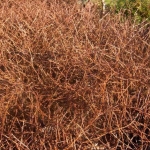
Coprosma Red Rocks is a divaricating native plant with small needle-like orange-red foliage, is found naturally near coastlines throughout N.Z. The colour intensifies with colder temperatures. An excellent groundcover plant for hot, dry conditions, on banks or as under planting. Very tolerant of wind, salt and dry periods. Hardy.
Flowering: Spring [September - November]
Fruiting: Autumn [March - May]
Tags: Coastal, DrainField
Coprosma rhamnoides (Red-fruited Coprosma)
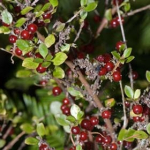
Coprosma rhamnoides is a dense tightly divaricating shrub. Tiny light green leaves. Stiff red/brown branches. Good for exposed, dry areas. N.Z. flora has a large number of shrubs with small tough leaves and wiry interlacing branches – divaricates. Some even have brown or grey new growth, giving a dead-like unattractive appearance. It is suggested that this may be a defensive growth mechanism to deter visits from browsing moa. Coprosma rhamnoides is a good example.
In October the plants develop small pale cream flowers which are dioecious (sexes separate). These flowers are wind pollinated. Drupes appear on the female plant in March-April small (3-4mm) red berries, turning dark red or black as they ripen.
Habitat: It is widespread in Canterbury and Westland in lowland to lower montane-scrubland and forest mostly as an understorey plant. It is less common higher in the montane zone.
Flowering: Spring [October - November]
Fruiting: Autumn [March - April]
Tags: Dioecious
Coprosma rubra
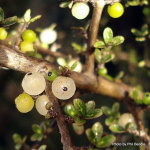
Coprosma rubra is a rare hardy shrub with stems of young branches a reddish colour. Yellow / White berries. Well-drained sites.
Small-leaved Coprosmas are good for revegetation projects, hedging, and adding texture into a garden. They are evergreen and suited to full sun to part shade. They produce berries from January to April that are dispersed by fruit-eating animals (frugivory). They also provide habitat for New Zealand’s declining lizard and gecko populations.
Mingimingi provides a tough shelter, providing good food for native birds and lizards, as well as ground cover.
Habitat: Lowland to montane. Usually in riparian forest and shrubland, especially on alluvial soils or those derived from calcareous parent materials.
Flowering: Spring - Summer [September - January]
Fruiting: Summer - Autumn [January - April]
Tags:
Coprosma virescens (Mingimingi)
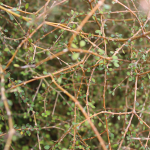
Coprosma virescens, mingimingi, is an upright shrub or small tree with attractive thin, pale-green leaves. Bark is mottled grey, pale-yellow and cream. The fruit are white or green-tinged, sometimes mottled with black. Thrives in cold conditions, partially deciduous putting the bold branch colour on show in winter.
Small-leaved coprosmas are good for revegetation projects, hedging, and adding texture to a garden. Mingimingi are evergreen and suited to full sun to part shade. They produce berries from January to April that are dispersed by fruit-eating animals (frugivory). They also provide habitat for New Zealand’s declining lizard and gecko populations. As attractors of these small animals, they are a pioneer shrub in revegetation projects. Mingimingi provides a tough shelter, providing good food for native birds and lizards, as well as ground cover for these.
Habitat: Lowland to lower montane. On well drained to poorly draining fertile soils (often overlying calcareous or base-rich igneous rocks). In forest and shrubland.
Flowering: Spring [September - November]
Fruiting: Summer [January - April]
Tags: PoorSoils
Corokia buddleioides
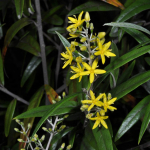
Corokia buddleioides has pale green/bronze glossy leaves. Yellow flowers (spring). Red berries (autumn). Ideal hedging. Distributed in the North Island. Northland south to outliers in New Plymouth and the volcanic plateau, not seen east of Bay of Plenty.
Habitat: Coastal to lowland forest and forest margins.
Flowering: Spring [September - December]
Fruiting: Summer - Autumn [January - May]
Corokia cotoneaster (Korokio)
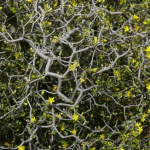
Corokia cotoneaster, or Korokio, is a good hedging and ornamental shrub. Corokia cotoneaster prefers to survive in areas that are not wet. It will grow and develop in dry, rocky, and dense soils. Attractive fine silver/grey foliage with bright yellow flowers in early summer. Densely interlaced branchlets. Red berries/seed. Evergreen. Very hardy to drought and cold.
As it is a tough plant that attracts birds and lizards, it is suitable for restoration projects. As part of the dry woodland community, it plays an important role in conditioning the soil. The soil conditioning creates a more hospitable environment for less robust species and broadleaf/podocarp forest succession. Other plants in this community include but are not limited to Discaria toumatou, Poa cita, Ozothamnus leptophyllus, Sophora prostrata, Melicytus alpinus and Cordyline australis.
Habitat: Found in scrub and on dry river flats and rocky places throughout the country.
Flowering: Spring [September - December]
Fruiting: Summer - Autumn [January - May]
Tags: DrainField, PoorSoils
Discaria toumatou (Matagouri)
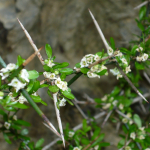
Discaria toumatou, commonly called Matagouri, is a tangle-branched, extremely thorny, divaricating shrub or small tree up to five metres tall. It has small leathery leaves close to the thorns, which are only abundant in spring or the shade. The flowers are tiny and white with no petals. It is the only New Zealand native plant that has thorns. Nitrogen-fixer. Common in dry shrublands of the eastern South Island.
It is most common in tussock grassland, stony areas and river beds. It is common in the eastern South Island, and found in a few coastal localities in the North Island south from the mouth of the Waikato River. As with other Discaria species it fixes nitrogen from the atmosphere with the help of symbiotic bacteria of the genus Frankia in its roots. It often grows in association with mingimingi (Coprosma propinqua), porcupine shrub (Melicytus alpinus, an alpine mahoe) and native brooms (Carmichaelia species). Seeds are dispersed by ballistic projection and water.
As a native plant matagouri has complete protection on public conservation land and a degree of protection on private land under the Resource Management Act 1991. In a notable case a 400 ha area of matagouri forest, including trees that may have been 150 years old, was illegally sprayed at the head of Lake Sumner in 2001.
Habitat: Found in dry riverbeds, open rocky places and sand dunes from coastal to subalpine.
Flowering: Spring - Summer [October - January]
Fruiting: Summer [December - March]
Tags: Rongoa
Fuchsia excorticata (Kotukutuku, Tree Fuchsia)
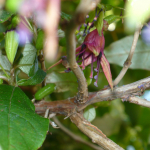 Sold Out
Sold Out
Fuchsia excorticata, also known as Kotukutuku, Tree Fuchsia, and New Zealand Fuchsia. Native to New Zealand and considered to be the worlds largest fuchsia. Attractive, small flowers begin to appear in mid spring. They are greenish-yellow then turn purple-red. followed by dark purple berries that are edible and tasting similar to tamarillo. It is easily recognised in its native environment by the characteristic appearance of its bark, which peels spontaneously, hanging in red papery strips to show a pale bark underneath. Plant in full sun or partial shade, hardy, semi-deciduous to deciduous.
Kōtukutuku is also a favoured food for bees. Other native trees that provide excellent food for honey bees and our own native bees (Leioproctus, Lasioglossum, and Hylaeus genera), are Psuedopanax arboreus, Cordyline australis, Schefflera digitata, Kunzea, and Pittosporum tenuifolium.
Habitat: Found in lowland and montane forests, especially along forest margins and streamsides where the soil is damp.
Flowering: Winter - Spring - Summer [June - January]
Fruiting: Summer [December - March]
Tags: Rongoa
Fuchsia procumbens (Creeping Fuchsia)
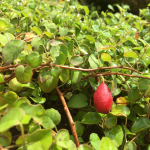
Fuchsia procumbens, or Creeping Fuchsia, is a rather exotic Fuchsia, unlike most common types, unique for its creeping habit. This species grows much like a groundcover, often not exceeding more than a few inches in height. Bears pretty rainbow flowers followed by firm-fleshed, edible berries.
It is now a rare species in the wild because of the destruction of its natural habitat and is listed as an endangered plant species.
Habitat: Fuchsia procumbens is a prostrate shrub that is endemic to coastal areas of the North Island of New Zealand. A strictly coastal species. F. procumbens has been collected from cobble/gravel beaches, coastal cliff faces, coastal scrub and grassland, dune slacks and swales, and from the margins of saltmarshes (in places where it would be inundated during spring tides).
Flowering: Spring - Summer [September - May]
Fruiting: Summer - Autumn [November - July]
Tags: RarePlant
Melicytus alpinus (Porcupine Shrub)
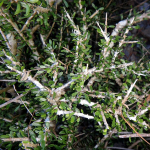
Melicytus alpinus get their common name, porcupine shrub, from the long, almost leafless, spindly branches which resemble the quills of a porcupine. Its leaves are narrow and generally have smooth margins with a few exceptions with serrated edges, however, they do only have a small amount of leaves and they are only approximately 1cm long. Hard and dense, slow-growing in coastal or alpine areas of southern North Island and the South Island it looks almost leafless. But most of the leaves are sheltered between the stiff interlacing stems as an adaptation to the harsh environment where the plant grows. Leaves are variable, leathery.
Melicytus alpinus is very well adapted to extreme weather conditions such as drought, which is why it can be found in areas such as the heavily modified high country of the South Island.
Melicytus alpinus is a habitat to many lizards endemic to New Zealand, this group of lizards include both skinks and geckos. This relationship is mutually beneficial as the lizards use the porcupine shrub as protection from weather and/or predators and in turn eat and spread the seeds from the shrub's berries.
Habitat: Occurs east of the Southern Alps in exposed rocky places between 600m and 1.300m. Found in the wild on very light sand or rocky soils, or on rock outcrops in full sun though it grows on any well-drained soil.
Flowering: Summer [November - January]
Fruiting: Autumn [February - April]
Tags: RarePlant
Melicytus crassifolius (Thick-leaved Mahoe)
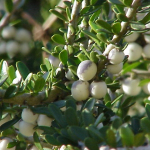
Melicytus crassifolius is heavily-branched, with arching stems that taper at the tips to a sharp point. The small bright olive green leaves are teardrop shaped. It has small, greenish, bell-shaped flowers which appear underneath branches in summer, They form in clusters along the branches. The fruit is small bright white berries and they develop late summer until early winter. Usually, a blue spot appears on the berry with age.
Habitat: This compact hard shrub is endemic to both the North and South Island where it is typically found along coastal lowlands (0-300 m a.s.l.). Usually coastal in open grey scrub, on talus and alluvial terraces, cobble beaches, cliff faces, and in coarse stable sand dunes (especially swales). Inland it may be found in open grassland, amongst kanuka stands and along river flats.
Flowering: Summer [August - January]
Fruiting: Autumn [February - May]
Melicytus ramiflorus (Mahoe, Whiteywood)
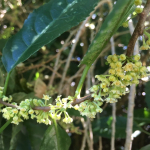
Melicytus ramiflorus, commonly known as Whiteywood or Mahoe, is one of our most common trees, found in forest and shrub throughout New Zealand and growing quickly to 5m or more. The pointed oval leaves are a bright green, with fresh growth being quite soft and an even brighter green. The bark is greyish white and becomes attractively mottled with lichens. Flowers in spring followed by numerous purple black berries. Whiteywood can be clipped for hedging or used as a shelter tree or filler, and will also make quite an attractive specimen. Avoid heavy frosts when young.
The berries of Māhoe are eaten by a number of native birds, including kererū and tui, and some geckos. It is frequently seen in areas of regenerating forest, particularly in areas of disturbed soil. Its early appearance in regenerating forests indicates that it is ideal for revegetation plantings.
Habitat: Abundant small tree of coastal, lowland, and lower montane forests throughout the country.
Flowering: Spring [November - February]
Fruiting: Summer [February - April]
Tags: Rongoa
Muehlenbeckia astonii (Pohuehue)
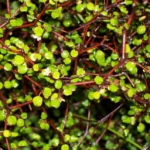 Sold Out
Sold Out
Muehlenbeckia astonii, Pohuehue, is a coastal divaricating shrub with a wiry interlacing habit. Small, bright-green heart-shaped leaves. This plant is extremely hardy, tolerating dry conditions and wind. Popular landscaping plant, providing great contrast. Makes an attractive topiary or hedge. Attracts birds, insects and lizards. Semi-deciduous. Hardy.
Unlike most New Zealand plants M. astonii is leafless in winter. This is when the distinctive branches add interest to the garden. It grows from a distinct trunk and has many fine reddish-brown to orange flexible branches that zigzag around one another to form a dense, interwoven ball. Its flowers, appearing from December to January, are tiny and are greenish to white or pinkish white. The fruits are sweet and edible, eaten by birds and lizards. The plant is an important host for several endemic insect species and in some cases their sole host.
Habitat: Coastal to lowland. This species is associated with “grey” scrub communities, largely confined to drier lowland parts of eastern New Zealand. It is found on moderate to high fertility soils. Its deep root system helps it survive in dry conditions, and can grow on open rocky hillsides and stony ground. It prefers free-draining, warm, sunny slopes, such as the mid-dune areas along the coast. The plant is often found in association with Coprosma crassifolia, Coprosma propinqua, Muehlenbeckia complexa, Discaria toumatou, Olearia solandri and Ozothamnus leptophyllus.
Flowering: Spring - Summer [August - January]
Fruiting: Summer - Autumn [October - June]
Tags: Rongoa
Muehlenbeckia axillaris (Creeping Pohuehue)
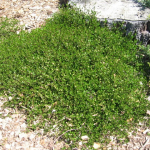
Muehlenbeckia axillaris, commonly known as Creeping Pohuehue or wire vine, is a low dense ground cover, forming wiry mats up to about 1 m in diameter. It spreads along the ground and even underground. It flowers prolifically in summer with masses of small creamy flowers. The flowers are yellowish white, 4-8 mm in diameter, and borne in groups of up to 3 in the axils. Male and female flowers often occur on the same plant and the female flowers form small opaque white fruit. Provides habitat for native copper butterflies. Birds and geckos love the fruit.
This groundcover has stems and small dark green leaves. Muehlenbeckia axillaris has thin wiry red-brown stems, with small dark green leaves that are less than 1 cm in diameter, and 2–4 mm thick. Prefers full sun. Tolerant of hot, dry conditions. Evergreen. Hardy.
Muehlenbeckia axillaris is primarily grown as an ornamental plant for its unique growth habit and attractive foliage. It is often used in rock gardens, coastal gardens, or other landscapes where its trailing habit can be appreciated. It is also used in erosion control and habitat restoration projects due to its ability to stabilize soil and provide cover for wildlife.
Habitat: Found in subalpine rocky places, riverbeds and and grasslands.
Flowering: Summer [November - April]
Fruiting: Autumn [December - April]
Tags: ErosionControl, Rongoa
Muehlenbeckia complexa (Scrambling Pohuehue)
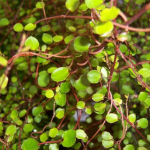
Muehlenbeckia complexa, commonly called scrambling or small-leaved Pohuehue, is quite vigorous and probably the best species for trimming and topiary. It is semi-deciduous, losing most, or all of its leaves over winter. Grows to 4m or more up suitable supports, and produces swollen white berries with black seeds. Leaves turn bronzy before dropping in late fall/early winter. Any reasonably well drained soil will suit this agreeable groundcover, and it'll tolerate drought, salt spray, and wind. Often found growing in the company of Plagianthus divaricatus.
M. complexa can form dense springy mounds, useful for suppressing weeds. In its native environment, it plays a key role in sealing human and natural disturbances on the forest edge. It also suppresses the growth of introduced weeds, such as blackberry, and promotes increased insect diversity. A wide variety of insect species are associated with M. complexa. It is an important host plant for several endemic species of copper butterflies including the coastal copper (Lycaena salustius). It is also a food source for lizards and birds such as tui, bellbird and kererū, which also feed on the buds and leaves.
Habitat: Found along rocky coasts as well as inland in coastal and montane forests.
Flowering: Spring - Autumn [October - June]
Fruiting: Winter [July - September]
Tags: ErosionControl, PoorSoils, Rongoa
Myrsine australis (Mapau, Red Matipo)
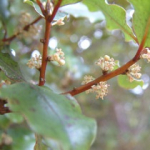 Sold Out
Sold Out
Myrsine australis, or Red Matipo, forms a handsome large shrub or tree with distinctive red branchlets and wavy leaf margins. Similar in appearance to Pittosporum tenuifolium. The cream flowers and later the black fruit are in clusters below the leaves. Used as a specimen, shrub border or hedge.
Habitat: Occurs in lowland forests. Common tree of regenerating and mature forest in coastal to montane situations.
Flowering: Spring - Summer [September - February]
Fruiting: Autumn [March - October]
Tags: Rongoa
Myrsine divaricata (Mapau, Weeping Matipo)
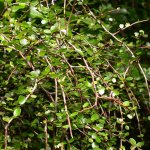
Myrsine divaricata is a small evergreen, bushy shrub, with spreading, drooping branches, which can grow to 6m high. The drooping branches give rise to woody interlacing (divaricating) branchlets bearing solitary leaves or leaves in groups. Tiny flowers, with pale yellow or red petals, occur in clusters. Evergreen.
Habitat: Found in subalpine scrub and forests, preferably where the ground is moist.
Flowering: Winter [June - November]
Fruiting: Spring - Autumn [August - April]
Pimelea prostrata (Pinatoro, NZ Daphne)
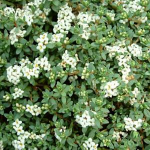 Sold Out
Sold Out
Pimelea prostrata, Pinatoro, or NZ Daphne, is a native groundcover with an attractive low growing plant with white flowers. It flowers prolifically over the summer months and is followed by small clear, white berries. The outstanding blue green foliage is a stand out with this groundcover. Is best grown in a free-draining soil in a full sun position. Excellent for sunny banks or rockeries.
Habitat: Coastal to montane. In open sites, such as coastal gravel, sand dunes, grasslands and mudstone cliffs.
Flowering: Spring - Autumn [September - May]
Fruiting: Winter [June - August]
Tags: Rongoa
Podocarpus nivalis (Snow Totara)
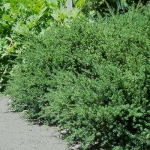
Podocarpus nivalis, commonly called Snow Totara, is a low growing, almost prostrate shrub found in sub alpine parts of New Zealand, although can grow at low altitude as well. It has small leathery olive-green leaves and edible red berries in the autumn. Fantastic option for a trimmed low hedge.
Habitat: Montane to alpine. Common in open tussock grassland and subalpine scrub.
Flowering: Spring [September - November]
Fruiting: Autumn [December - June]
Podocarpus totara (Totara)
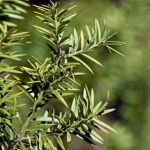
Podocarpus totara, is a classic NZ Native with needle like leaves, olive green, orange-red fruit. Bark red / brown, good shaped tree with durable timber. Tolerates wide range of sites. Evergreen. Frost tender when young.
Commonly known as Totara, trees are either male or female with the female trees having bright red, berry-like fruit in autumn. Male trees do not bear fruit. It grows with a broad and spreading habit to eventually reach 20 m tall and 10 m wide, and can be included in a medium sized garden due to its slow growth rate. Best results with this tree are achieved when it is grown in full sun on a well-drained site. It is tolerant of mild drought, frost, cool climates, some wind, and coastal environments. Totara is commonly included in a mixed planting in a large garden, used in native plantings, or grown as a specimen.
Habitat: Widespread and at times abundant tree of lowland, montane and lower subalpine forest. May also form a vegetation type in which it is the dominant species.
Flowering: Spring [October]
Fruiting: Autumn [March - April]
Tags: Rongoa
Pseudopanax arboreus (Whauwhaupaku, Fivefinger)
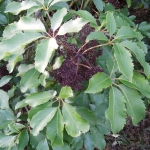
Pseudopanax arboreus, commonly called Fivefinger, is one of New Zealand's most common native trees found from Cape Reinga to Bluff in lowland forests. Its particular form of a glossy, five to seven fingered leaf along with quick and luxuriant growth. It grows into a small stout tree up to 5 metres high and grows well in most soils and situations. Fast growing with small purplish black berries in autumn.
History of use: New Zealand Beekeepers Magazine rates Pseudopanax arboreus as a star performer for food for bees. The trees provide abundant pollen and copious, rich nectar very early in the season when few other species are in flower (from June to August). Plant in good numbers clustered together to amplify the availability of flowers for bee feed. Bees love the small scented green flowers that are followed by bunches of dark purple fruits enjoyed by birds from August to February. Flower buds can be easily mistaken for ripe fruit whereas clusters of fruit are actually ripe one year after flowering.
Habitat: Coastal to montane. Moist broadleaf forest. Frequently epiphytic. A frequent component of secondary forest and forest margins. Tolerant of moderate frosts and coastal conditions but should be sheltered from strong winds.
Flowering: Winter [June - August]
Fruiting: Spring - Summer [August - February]
Tags: Rongoa, WinterPollen
